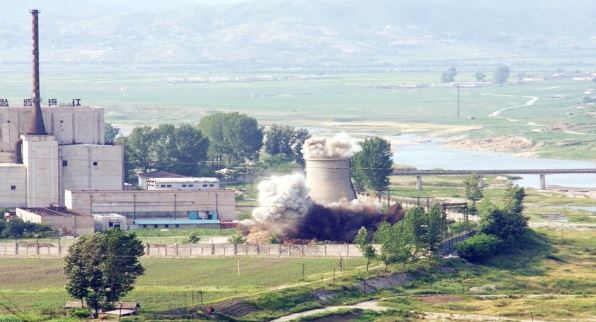The Yongbyon Scientific Research Center has been at the center of nuclear talks between the US and North Korea for more than two decades.
Built in the 1960s under the leadership of North Korea’s founding leader Kim Il-sung, the Yongbyon complex has expanded in scale by adding a 5-megawatt-electric reactor, 100-megawatt-thermal experimental light water reactor, uranium enrichment buildings as well as spent fuel reprocessing facilities and research buildings.
Built in the 1960s under the leadership of North Korea’s founding leader Kim Il-sung, the Yongbyon complex has expanded in scale by adding a 5-megawatt-electric reactor, 100-megawatt-thermal experimental light water reactor, uranium enrichment buildings as well as spent fuel reprocessing facilities and research buildings.

Just as Siegfried Hecker, a leading nuclear scientist at Stanford University who has visited the site four times, called Yongbyon “the heart of nuclear program” of North Korea, it produces the two key materials used in making nuclear weapons -- plutonium and highly enriched uranium -- at the same location. The facility also produces the tritium it needs to make nuclear warheads small enough to fit its long-range missiles.
“North Korea’s nuclear capabilities will be continuously reduced after shutting down and dismantling the Yongbyon nuclear complex, as it will halt additional production of plutonium that could be used for the compact hydrogen bomb and other atomic bombs,” said Hong Min, director of the North Korean research division of the Korea Institute for National Unification.
In 2010, Hecker said he witnessed 2,000 centrifuges capable of producing highly enriched, weapons-grade uranium. He now believes the facility has since doubled in size.
Yongbyon is estimated to have 50 kilograms of weaponized plutonium, enough for six to 10 bombs, and a highly enriched uranium inventory of 250 to 500 kilograms, sufficient for 25 to 30 nuclear devices.
Experts say North Korea seemed to have started operating the uranium enrichment program as it faced difficulties obtaining plutonium from its main 5-megawatt-electric reactor following its frozen period in the 1990s and mid-2000s.
Pyongyang had twice agreed to halt operations and allow outside experts to inspect the site in exchange for aid. The main reactor was shut down in the 1990s but started up again in 2003 after the breakdown of the deal. In 2007, a new agreement to close the reactor led to the demolishment of the cooling tower the following year. But as the deal also fell apart, North Korea used river water to cool the reactor.
“The uranium enrichment facility which started running in 2010 requires significant operating experience for high performance. The North may have a covert space to accumulate the experience,” said Ahn Jin-soo, a former researcher at the Korea Institute of Nuclear Nonproliferation and Control.
Yongbyon’s light water reactor is known to be capable of producing 10 to 15 kilograms of plutonium a year, but the quality falls short of weapons-grade plutonium, Ahn said.
By Park Han-na (hnpark@heraldcorp.com)



![[Exclusive] Korean military set to ban iPhones over 'security' concerns](http://res.heraldm.com/phpwas/restmb_idxmake.php?idx=644&simg=/content/image/2024/04/23/20240423050599_0.jpg&u=20240423183955)




![[Pressure points] Leggings in public: Fashion statement or social faux pas?](http://res.heraldm.com/phpwas/restmb_idxmake.php?idx=644&simg=/content/image/2024/04/23/20240423050669_0.jpg&u=)











